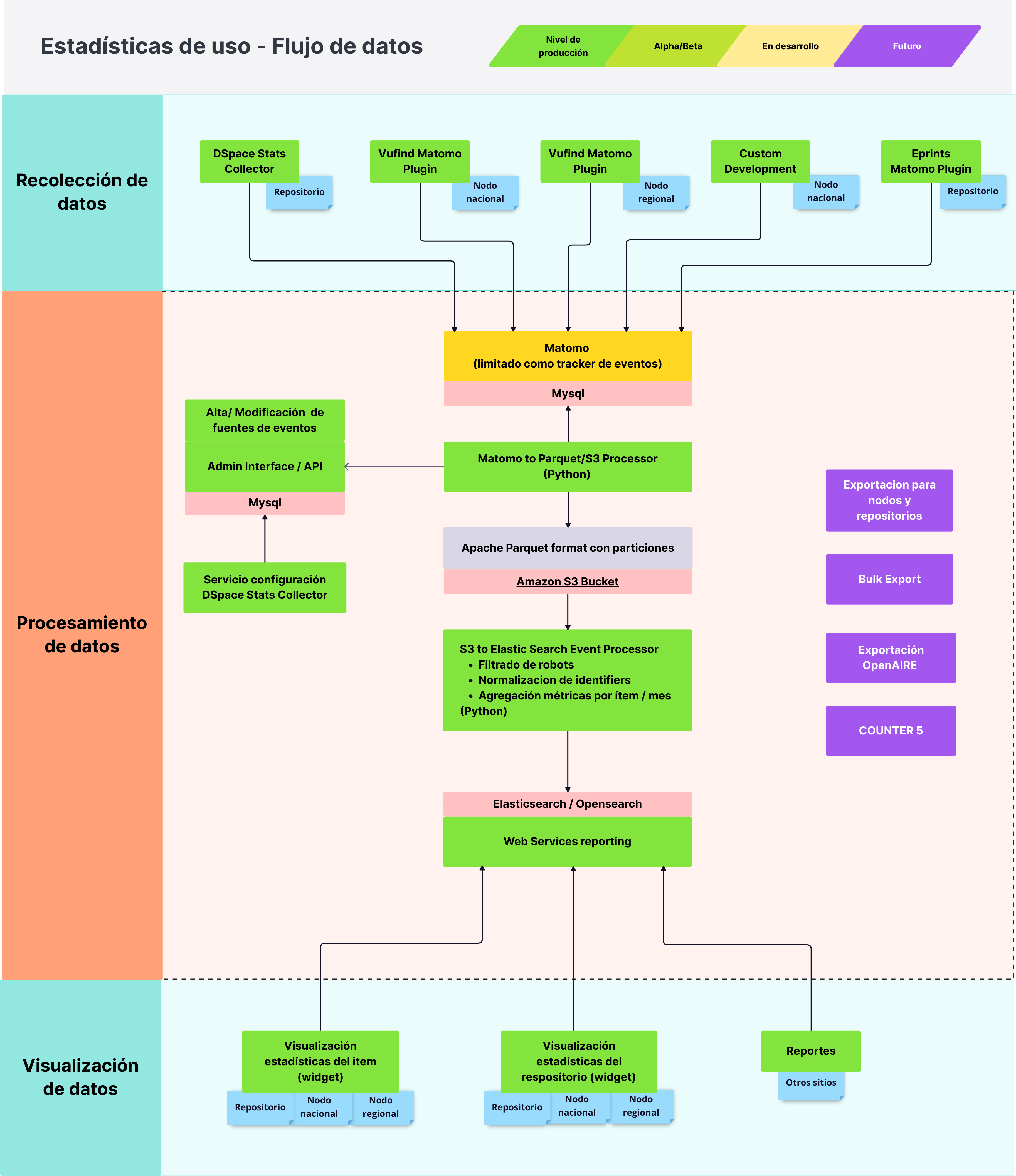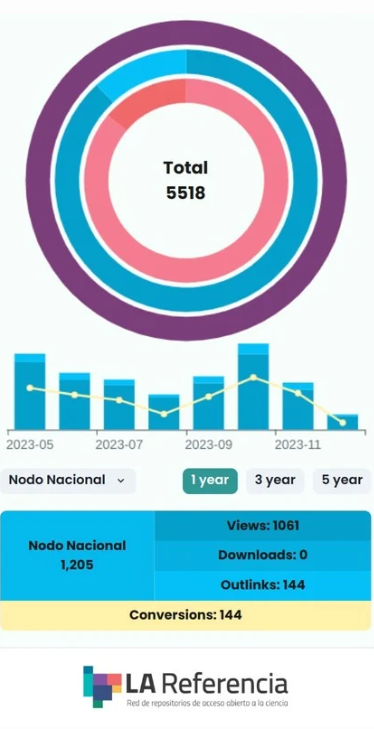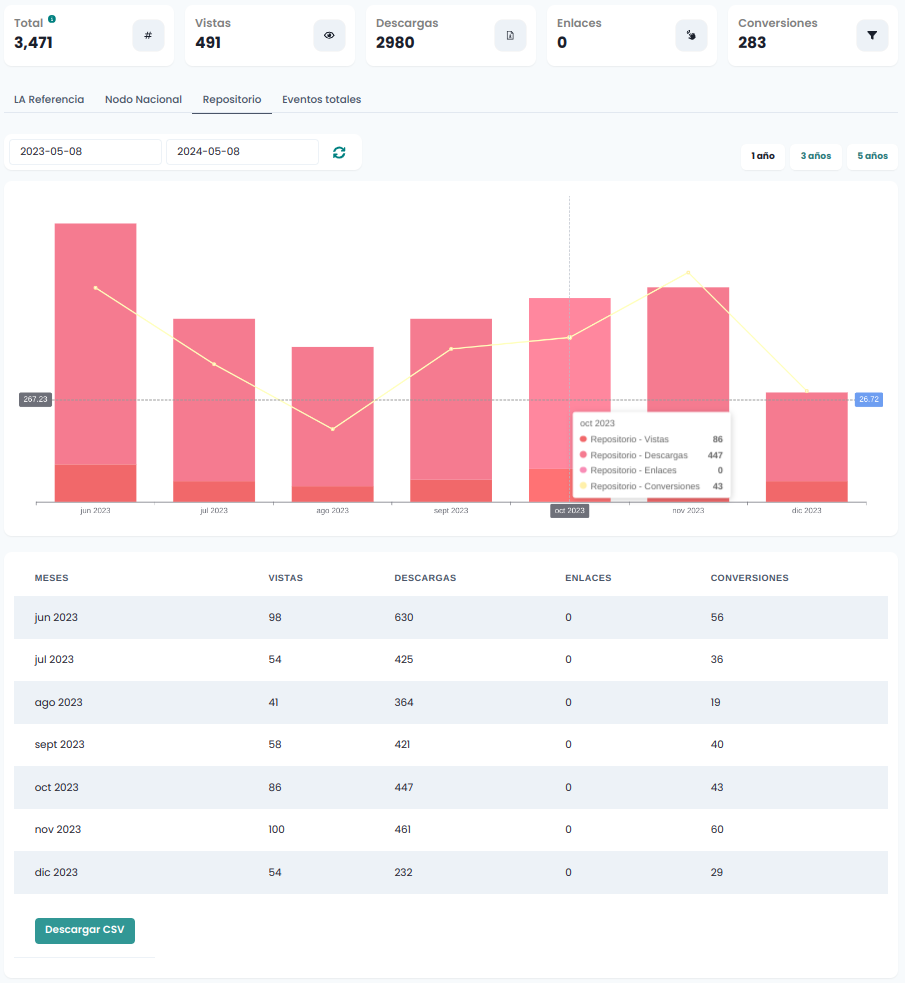Documentation
Guides and technical documentation
01. Introduction
The advancement of Open Science largely depends on the development of standardized metrics that can measure the usage and impact of research across different communities and platforms.
The Need for Better Research Metrics
Traditionally, indicators like citations and journal impact factors have been used for this purpose, but they are insufficient to capture the full spectrum of how research outcomes are utilized by society.
Why Traditional Metrics Fall Short
Citation metrics only capture formal academic impact, missing:
- Downloads from diverse user communities
- Usage patterns across different regions
- Other applications outside academia
About LA Referencia
LA Referencia, as a key player in the academic community of Latin America, has led efforts to introduce common usage statistics that complement existing metrics. This project aims to provide a more comprehensive view of how research outputs are used, both by the scientific community and the general public. Through the development of a robust usage statistics service, LA Referencia is moving toward a deeper understanding and increased visibility of the impact of open research.
Recent Advancements
2023/2024 Progress
During the 2023/2024 cycle, the LA Referencia Usage Statistics project, with funding support from SCOSS, underwent significant advancements. It migrated to a more flexible and scalable architecture, improving the system's reliability and enabling the integration of new tools.
Key Achievements
Enhanced Event Tracking
Implementation of more efficient event tracking systems to capture research usage.
Optimized Data Storage
Optimization of data storage through solutions like Amazon S3, ensuring scalability.
Improved Bot Detection
Enhanced bot detection mechanisms to ensure metric accuracy and data quality.
Advanced Identifier Normalization
Introduction of an advanced identifier normalization system to standardize references.
Custom Repository Widgets
Development of custom widgets for repositories, facilitating greater interaction and analysis of usage data.
These advancements enhance LA Referencia's ability to provide a more accurate and detailed view of research usage in the region.

02. Event Sending Components
Usage events occur in repositories and aggregators where research outputs are made visible. Therefore, in order to preserve, process, and generate services from these events, it is necessary to have components installed at the sources to periodically transmit the usage events.
DSpace Stats Collector
DSpace is widely used repository software. This Python component, which operates independently and securely, sends the usage events stored in DSpace (versions 4, 5, 6, 7) using the Matomo tracker protocol.

Access to code and installation manuals
https://github.com/lareferencia/dspace-stats-collector
Instalación Actualización Desinstalación
Exportador de eventos antiguos (beta)
Vufind Aggregators
For aggregators using Vufind software https://vufind.org, there is a plugin that sends events in real-time using the Matomo tracker protocol.
Access to code and installation manuals
https://vufind.org/wiki/configuration:usage_stats
Eprints Repositories
For Eprints repositories, there is a plugin implemented by OpenAIRE that sends events using the Matomo tracker protocol.
Access to code and installation manuals
https://github.com/openaire/EPrints-OAPiwik
Read more
03. LA Referencia Usage Statistics Infrastructure
The LA Referencia statistics system operates on a shared infrastructure in Amazon AWS, maintained as part of the services provided by LA Referencia thanks to contributions from member countries and SCOSS support.
The infrastructure is based on a set of open components published on GitHub as part of the commitment to contribute to the Global Open Science Ecosystem.
- Database, management, and identifier normalization libraries components
- Storage and event preservation components
- Processing, cleaning, normalization, and event aggregation components
- Web services components for repositories and aggregators
By clicking here, you can access all the source code for the components
Read more04. Item-Level Statistics Visualization Component

This visual component aims to present usage statistics at the repository, national aggregator, and regional aggregator levels for an item based on its OAI identifier. It is centrally maintained in a CDN and can be embedded on the item page in repositories and portals. To install it, it is necessary to coordinate with the corresponding LA Referencia national node to ensure the presence of events.
- Installation documentation: https://github.com/lareferencia/lrw
05. Aggregated Historical Statistics Visualization Component

This visual component aims to present aggregated usage statistics at the repository, national aggregator, and regional aggregator levels for a specific source. It is centrally maintained in a CDN and can be embedded in repositories and portals. To install it, it is necessary to coordinate with the corresponding LA Referencia national node to ensure the presence of events.
06. Understanding Usage Metrics
The statistics presented in the widget and LA Referencia platform are built from events that occur at three different levels: institutional repositories, national aggregators, and the regional aggregator.
Metrics Across Different Levels
The usage statistics presented in LA Referencia tools are constructed from events that occur at three distinct levels:
- Institutional repositories - Where the original content is hosted
- National aggregators - Which harvest metadata from repositories within a country
- Regional aggregator - LA Referencia, which integrates records from different Latin American countries and Spain
Understanding Each Metric
Below we explain the meaning of each metric, considering the differences according to the level at which the events are generated:
Visit
Refers to access to an object's detail page (for example, a publication record). This event can be recorded both in the repository and in the aggregators.
Download
Corresponds to the action of accessing the attached file (such as a PDF). This event occurs exclusively in the repository.
Outlink
This metric is recorded only in aggregators (national or regional) and measures how many times a user clicks on the link that leads from the object record in the aggregator to the item page in the original repository. It reflects interest in accessing the primary source from a broader search environment.
